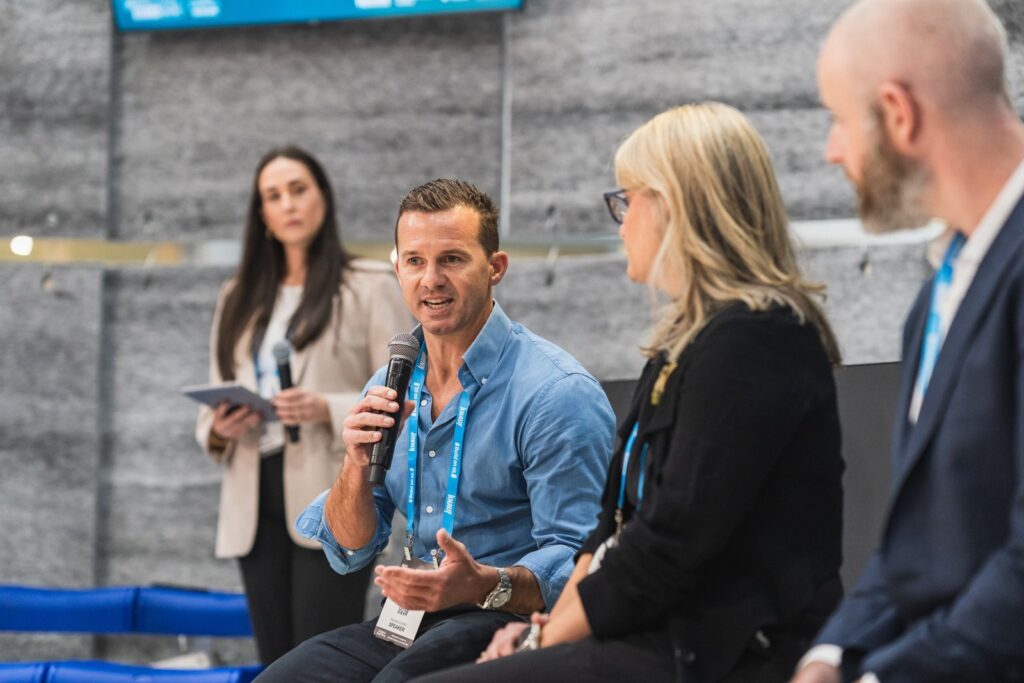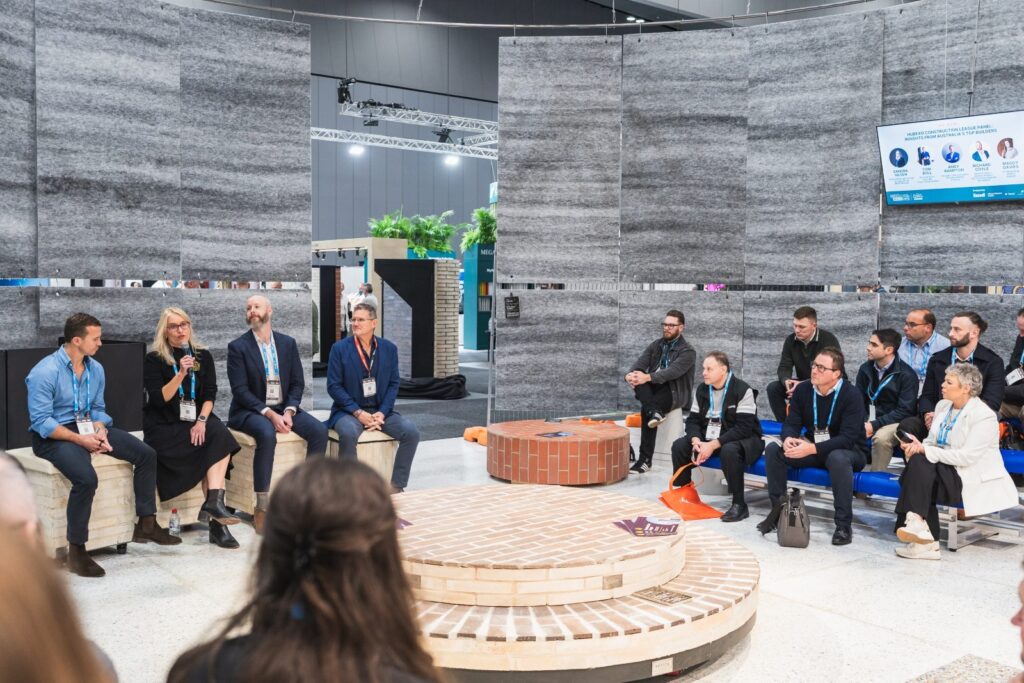- หน้าหลัก
- >
- Construction Leaders Call for Smarter Risk, Smarter Tech at ArchiBuild 2025
Construction Leaders Call for Smarter Risk, Smarter Tech at ArchiBuild 2025

As Australia’s construction sector continues to navigate a complex and shifting landscape, construction leaders came together at BCI’s Construction League Panel at ArchiBuild 2025 for a frank, solutions-focused discussion on what comes next.
The panel coincided with the release of the 2025 Construction League report, which ranks the top 50 construction firms in Australia by the total value of projects commenced last year in eligible sectors, including commercial, community, industrial, legal and military, and multi-residential. It offers a breakdown of each firm’s activity, including the total number of projects, average project value and total project value, with a further breakdown of the top 10’s projects by sector and location.
The session featured Sandra Nilsen, General Manager Design and Engineering at BESIX Watpac; Tom Bull, Director and Co-Founder at Texco; Andy Rampton, Industry Transformation Director APAC at Procore; and Richard Coyle, Head of Sales – Eastern Region at BCI Central.
Together, they unpacked the industry’s most pressing inflection points—from contract reform and AI integration to workforce shortages and the shifting dynamics of project risk. It was a discussion that reinforced the central theme of the day: the need for smarter risk and smarter tech.
The consensus? While margins remain tight and insolvencies continue to rise, the builders shaping the future aren’t retreating; they’re recalibrating.
Labour shortages, an ageing workforce, planning bottlenecks, these remain real challenges. Yet the tone at the Construction League Panel was far from defeatist. Instead, there was a clear shift toward smarter strategies: investing in digital maturity, renegotiating risk and rethinking how people, tools and capital are deployed.
Here are some of the key takeaways from the discussion:
Bull: Rewriting the contract playbook
For Tom Bull, Director at Texco, a specialist in industrial design and construct (D&C), the key lesson from the past two years was simple: too many builders are carrying risks they shouldn’t.
Texco ranked 17th in this year’s Construction League, with 18 project commencements in 2024 totalling more than $517 million in value. Much of that work is in the industrial space, including logistics hubs, cold storage and operationally complex D&C builds.
“We re-traded every single head contract with our 10 biggest clients,” Bull said. “There were too many clauses pushing developer risk onto builders, things that were completely outside our control and sending companies to the wall.”

To stay active, Texco sat down with developers and reset expectations, often successfully.
“Most of them sat at the table and re-traded,” Bull said. “It showed a genuine willingness across the industry to rethink how we do business.”
For Bull, it’s also a sign of maturity: an industry slowly shedding outdated contract models and starting to prioritise shared responsibility, especially in a market where volatility has become the norm.
Beyond commercial risk, Bull flagged structural constraints too, particularly around land and infrastructure in Melbourne’s west, where industrial demand is high, but supply chain realities are biting. In one case, a major facility had to be powered by $10 million worth of diesel generators due to long delays in grid connection.
Nilsen: Complex projects, clear intentions
Sandra Nilsen, General Manager of Design and Engineering at BESIX Watpac, reflected on the business’s pivot toward complex, high-value work: data centres, healthcare, waste-to-energy, and stadia.
BESIX Watpac ranked first in this year’s Construction League, with over $3.4 billion in project commencements—underscoring the scale and ambition behind its current portfolio, and the strategic discipline now guiding its pipeline.
“We stepped back and focused on tenders where we could add real value and differentiate through design or construction,” Nilsen said.

That focus, she noted, has helped the company weather volatility by choosing projects that play to its strengths and allow for greater control across delivery. It’s a calculated shift toward quality over quantity.
She echoed Bull’s call for contract reform and flagged the critical need for a more reliable and better-communicated government pipeline.
“We can’t have staff sitting on the bench waiting for tenders that never come. Government needs to publish and stick to timelines.”
Reflecting on BESIX Watpac’s recent success, Nilsen made clear that industry leaders have a responsibility to set the tone on diversity and to build a culture where participation isn’t just allowed, but actively enabled.
“We’ve got to be open to more diversity, to tackle the ageism that’s out there, to bring women into what is still a male-dominated space. It’s got to be an inclusive place for everyone to participate. We don’t have an option.”
Rampton: Construction’s digital drag
Andy Rampton, Procore’s Industry Transformation Director, didn’t mince words: construction is still lagging when it comes to tech.
“I’ve been in the industry for 35 years and it feels like we’ve been talking about digital transformation forever. It still isn’t happening.”
The gap, he said, isn’t tools; it’s follow-through.
“Tech companies promise the world and deliver dashboards. We need to help contractors solve problems, not just measure adoption.”

Part of the problem, Rampton noted, is that tech is often layered on top of broken systems, rather than reshaping the way projects are delivered. The focus now, he argued, must shift from implementation to integration, technology that actually drives better outcomes on site.
Still, he sees a potential turning point in AI:
“Ninety-five percent of construction companies are already using AI. It might not be mature or embedded in daily workflows yet, but it’s breaking down long-held myths around adoption. This could be what finally pushes the industry through its digital transformation.”
For Rampton, the challenge isn’t whether the industry can change; it’s whether it will do so with intention, before disruption forces its hand.
Coyle: Data’s the new differentiator
Richard Coyle, Head of Sales – Eastern Region at BCI Central, delivered a clear-eyed view of the construction pipeline and the stark divergence emerging across sectors and states.
“Across many sectors, we’re only seeing 25 to 30% of the project starts we recorded last year”, Coyle said, pointing to a noticeable slowdown in Victoria’s residential market, where approval timelines have stretched from a national average of 10 months to 15–16 months.
Meanwhile, other sectors are charging ahead. “In terms of value, legal and military commencements in 2025 have already surpassed the full-year totals from 2024, despite fewer actual projects,” Coyle said.

Coyle also pointed to how builders are responding—not just by pulling back, but by sharpening their approach. Tools like หลีดแมเนเจอร์ (Leadmanager) และ Analytix, he said, are helping firms track shifts in real time, refine their tendering strategy, and focus only on the opportunities that align with their strengths.
“Builders can’t afford to take a scattergun approach anymore”, Coyle said. “It’s about knowing what you’re good at, what’s profitable, and where you can outperform the competition.”
With over 13,000 monthly project updates across Australia and New Zealand, BCI Central is giving the industry a sharper lens and a vital edge as conditions remain uncertain.
Explore the latest rankings of Australia’s top builders in this year’s Construction League. Take a deeper dive by downloading the report now.




